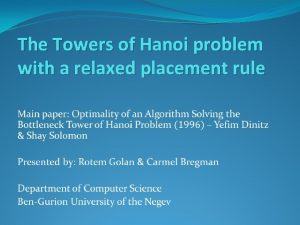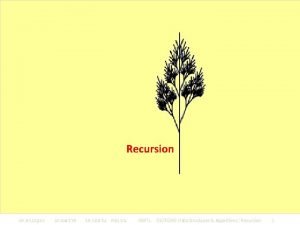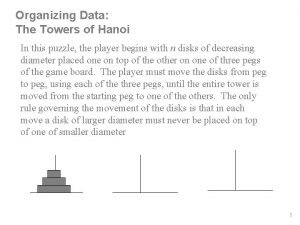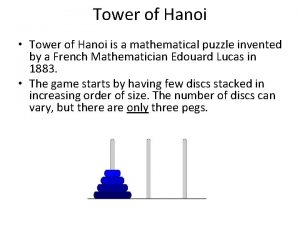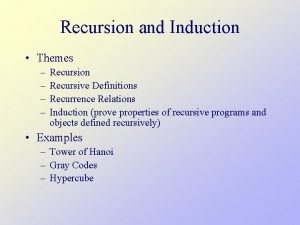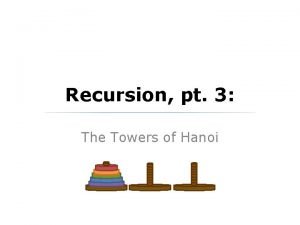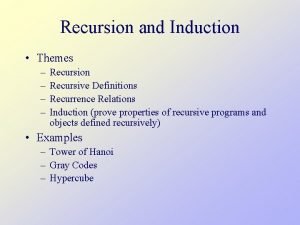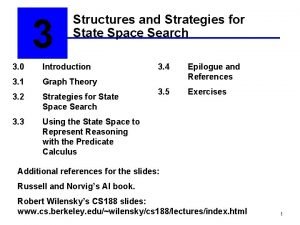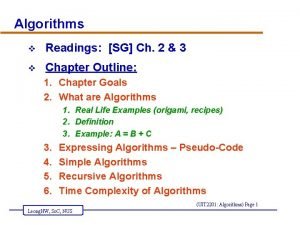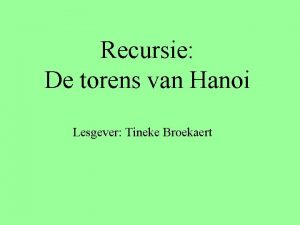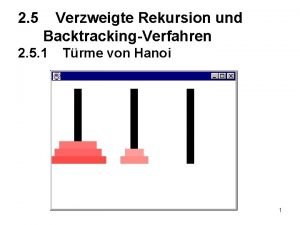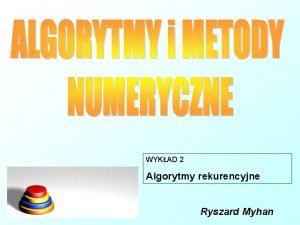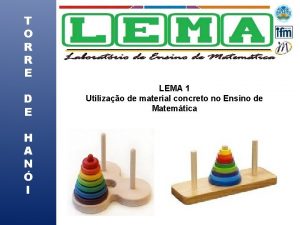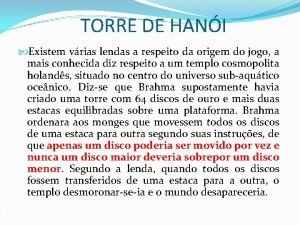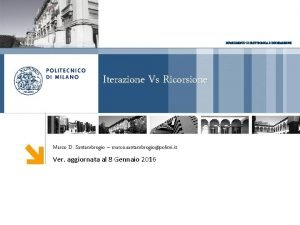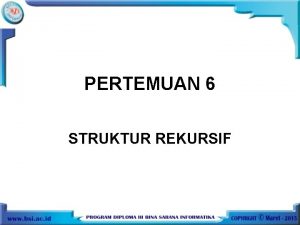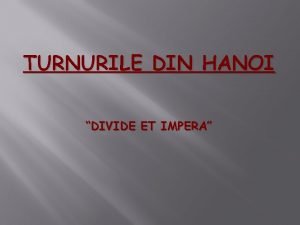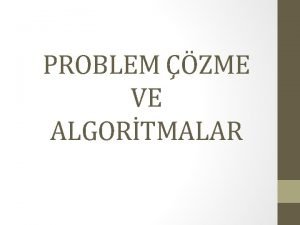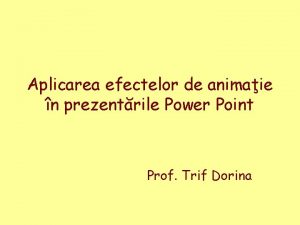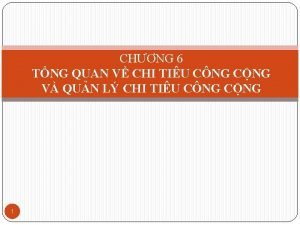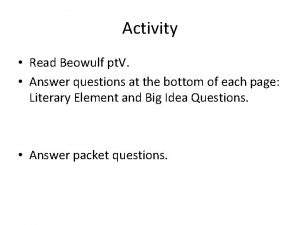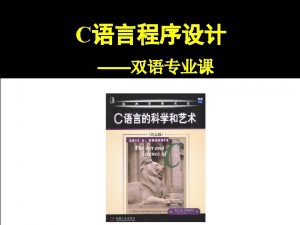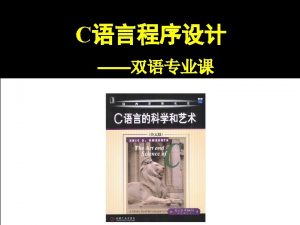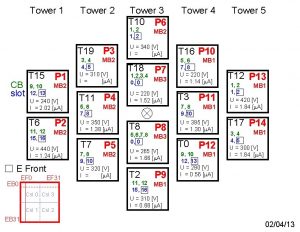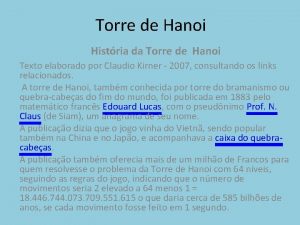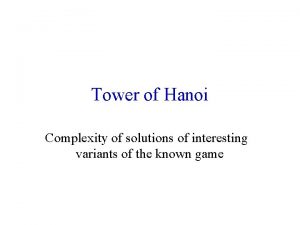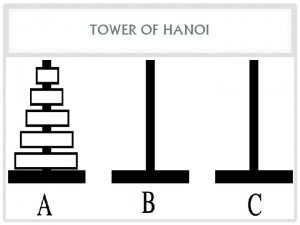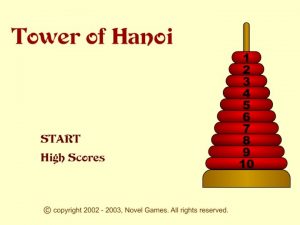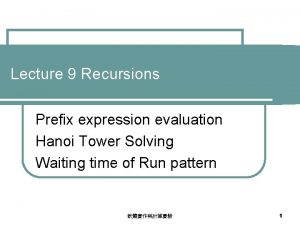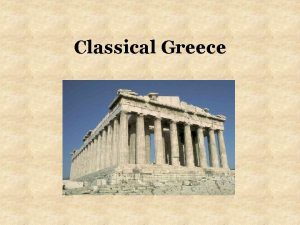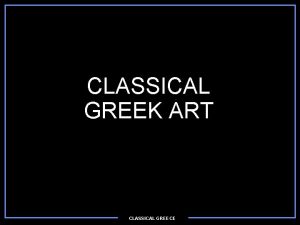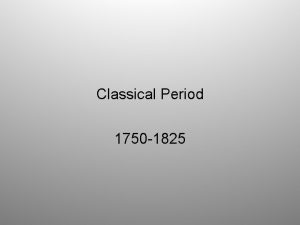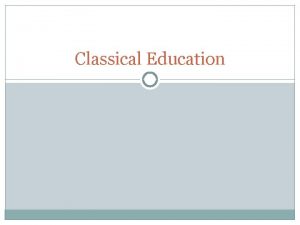The Magnetic Tower of Hanoi 1 The Classical









![A. The Classical Tower of Hanoi [To. H] k=N k=2 k=1 A model set A. The Classical Tower of Hanoi [To. H] k=N k=2 k=1 A model set](https://slidetodoc.com/presentation_image_h2/8f17ef004004bad0c38913773be25219/image-10.jpg)












![B. The Magnetic Tower of Hanoi [MTo. H] 23 B. The Magnetic Tower of Hanoi [MTo. H] 23](https://slidetodoc.com/presentation_image_h2/8f17ef004004bad0c38913773be25219/image-23.jpg)
















































![References [1] "The Magnetic Tower of Hanoi", Uri Levy, Journal of Recreational Mathematics 35: References [1] "The Magnetic Tower of Hanoi", Uri Levy, Journal of Recreational Mathematics 35:](https://slidetodoc.com/presentation_image_h2/8f17ef004004bad0c38913773be25219/image-72.jpg)









- Slides: 81

The Magnetic Tower of Hanoi 1

The Classical Tower of Hanoi 2

Classical To. H – video-clip 1 (0: 53) Click link to play a You. Tube video 1. http: //www. youtube. com/watch? v=EHtk 7 k. Zqo. VY 3

Positional Notations 4

Babylonian mathematics (3 -rd millennium BC) It originated with the ancient Sumerians in the 3 rd millennium BC , was transmitted to the Babylonians , and is still used - in modified form - for measuring time , angles , and geographic coordinates. http: //en. wikipedia. org/wiki/Base_60 5

A short reminder of bases (“Positional Notation”) Positional notation From Wikipedia, the free encyclopedia Indian mathematicians developed the Hindu-Arabic numeral system , the modern decimal positional notation, in the 9 -th century. 2506 = 2 x 103 + 5 x 102 + 0 x 101 + 6 x 100 [ Number = SUM npos. *Base ] (Pos. – 1) http: //en. wikipedia. org/wiki/Place_value_system 6

A short reminder of bases – base 2 Base 2 Weight 24 23 22 21 20 Position 5 4 3 2 1 Number 1 0 1 10111(2) = 1*24 +0*23 +1*22 +1*21 +1*20 10111(2) = 16(10) + 4(10) + 2(10) + 1(10) = 23(10) http: //en. wikipedia. org/wiki/Place_value_system 7

A short reminder of bases – base 3 Base 3 Weight 34 33 32 31 30 Position 5 4 3 2 1 Number 1 0 1 2 2 10122(3) = 1*34 +0*33 +1*32 +2*31 +2*30 10122(3) = 81(10) + 9(10) + 6(10) + 2(10) = 98(10) http: //en. wikipedia. org/wiki/Place_value_system 8

The Classical Tower and base 2 9
![A The Classical Tower of Hanoi To H kN k2 k1 A model set A. The Classical Tower of Hanoi [To. H] k=N k=2 k=1 A model set](https://slidetodoc.com/presentation_image_h2/8f17ef004004bad0c38913773be25219/image-10.jpg)
A. The Classical Tower of Hanoi [To. H] k=N k=2 k=1 A model set of the Towers of Hanoi (with 8 disks) The classical Tower of Hanoi "puzzle" or "mathematical game" invented by the French mathematician Edouard Lucas in 1883. http: //en. wikipedia. org/wiki/Tower_of_Hanoi 10

Classical To. H – video-clip 2 (1: 14) Click link to play a You. Tube video 2. http: //www. youtube. com/watch? v=3 e. GBh. SSxff. M 11

To. H – Puzzle Description Puzzle Components: Three equal posts A set of N different-diameter disks Puzzle-start setting: N disks arranged in a bottom-to-top descending-size order on a "Source" Post Move: Lift a disk off one Post and land it on another Post Disk-placement rules: The Size Rule: A small disk can not "carry" a larger one (Never land a large disk on a smaller one) Puzzle-end state: N disks arranged in a bottom-to-top descending-size order on a "Destination" Post (one of the two originally-free posts) 12

To. H – Recursive Relations 13

To. H – Number of Moves k N 1 2 3 4 5 6 7 1 1 2 3 1 2 4 4 1 2 4 8 5 1 2 4 8 16 6 1 2 4 8 16 32 7 1 2 4 8 16 32 64 8 128 SUM 2 N - 1 1 1 3 3 7 7 15 15 31 31 63 63 127 255 14

Classical To. H – spans “base 2” k N 1 2 3 4 1 1 2 20 1 2 3 20 1 21 2 4 4 20 1 21 2 22 4 8 20 21 22 23 SUM 2 N - 1 1 1 3 21 -1 3 7 22 -1 7 15 23 -1 15 24 -1 15

A “Base 2” game Base 2 Element (k) 1 2 3 4 5 # of moves 1 2 4 8 16 # of moves 20 21 22 23 24 k=N k=2 k=1 16

The Classical Tower Spans base 2 17

Challenge: invent a “base 3” game Can we invent a game that Spans base 3? 18

Elements of a“Base 3” game Base 3 Element (k) 1 2 3 4 5 # of moves 1 3 9 27 81 # of moves 30 31 32 33 34 19

Challenge: invent a “base 3” game So - can we invent a game that Spans base 3? 20

Yes we can 21

MTo. H – video-clip 3 (1: 29) Click link to play a You. Tube video 3. http: //www. youtube. com/watch? v=n. Uo. HHea. J 4 e. I 22
![B The Magnetic Tower of Hanoi MTo H 23 B. The Magnetic Tower of Hanoi [MTo. H] 23](https://slidetodoc.com/presentation_image_h2/8f17ef004004bad0c38913773be25219/image-23.jpg)
B. The Magnetic Tower of Hanoi [MTo. H] 23

MTo. H – when we where Young and Brave Yaron (10) and a home-made Magnetic Tower of Hanoi Rehovot, Israel - Autumn 1984. 24

MTo. H – Puzzle Description Puzzle Components: Three equal posts. A set of N different-diameter disks Each disk's "bottom" surface is colored Blue and its "top" surface is colored Red Puzzle-start setting: N disks arranged in a bottom-to-top descending-size order on a "Source" Post The Red surface of every disk in the stack is facing upwards Move: Lift a disk off one post Turn the disk upside down and land it on another post Disk-placement rules: ♣The Size Rule: A small disk can not "carry" a larger one (Never land a large disk on a smaller one) ♣The Magnet Rule: Rejection occurs between two equal colors (Never land a disk such that its bottom surface will touch a co-colored top surface of the "resident" disk) Puzzle-end state: N disks arranged in a bottom-to-top descending-size order on a "Destination" Post (one of the two originally-free posts) 25

MTo. H – Solving the N=2 Puzzle 2 1 4 3 26

Colored MTo. H – video-clip 4 (1: 24) Click link to play a You. Tube video 4. http: //www. youtube. com/watch? v=D_xfu. COh 1 S 0 27

B 1. The Colored MTo. H S D I S I D 28

The Colored MTo. H – Number of Moves k N 1 2 3 4 5 6 7 1 1 2 1 3 3 1 3 9 4 1 3 9 27 5 1 3 9 27 81 6 1 3 9 27 81 243 729 8 2187 SUM (3 N - 1)/2 1 1 4 4 13 13 40 40 121 364 1093 3280 29

Colored MTo. H – spans “base 3” k N 1 2 3 4 1 1 2 30 1 3 3 30 1 31 3 9 4 30 2 1 31 2 3 32 2 9 27 30 2 31 2 32 2 33 2 5 SUM (3 N– 1)/2 1 1 (31 -1)/2 4 4 (32 -1)/2 13 13 (33 -1)/2 40 40 (34 -1)/2 30

Challenge met And the fun just begins 31

MTo. H – The Three Versions B 1. The Colored MTo. H B 2. The Semi-Free MTo. H B 3. The Free MTo. H 32

B 2. The Semi-Free MTo. H SS ID DI An MTo. H is Semi-Free if ♣ One of its posts – say – S, is permanently colored – say Red ♣ Another post – say – D, is permanently and oppositely colored ♣ The third post – I - is Free (has a Neutral color at the start of the algorithm) ♣ We need to move N disks from Post S to Post D using Post I 33

The Semi-Free MTo. H – Number of Moves k N 1 k - odd k - even N - odd N - even 2 3 4 5 6 7 1 1 2 1 3 3 1 3 7 4 1 3 7 21 5 1 3 7 21 61 6 1 3 7 21 61 183 7 1 3 7 21 61 183 547 8 SUM 1 4 11 32 93 276 823 1641 2464 34

The Semi-Free MTo. H – Duration Ratio 35

The Free MTo. H • The “ 67” Algorithm • The “ 62” Algorithm 36

The Free MTo. H – video-clip 5 (2: 43) Click link to play a You. Tube video 5. http: //www. youtube. com/watch? v=b. Ztx 5 gexdd. I 37

MTo. H FREEDOM “It is (this) FREEDOM that makes the Magnetic Tower of Hanoi Puzzle so COLORFUL” 38

B 3. The Free MTo. H – The “ 67” Algorithm 39

The “ 67” Algorithm – Number of Moves k N 1 2 3 4 5 6 7 1 1 2 1 3 3 1 3 7 4 1 3 7 19 55 6 1 3 7 19 55 163 7 19 55 163 487 8 1459 SUM 3(N-1) + N-1 1 1 4 4 11 11 30 30 85 85 248 735 2194 40

The “ 67” Algorithm – Duration Ratio 41

B 3. The Free MTo. H – The “ 62” Algorithm 42

The “ 62” Algorithm – Number of Moves k N 1 2 3 4 5 6 7 1 1 2 1 3 3 1 3 7 4 1 3 7 19 53 6 1 3 7 19 53 153 7 19 53 153 455 8 SUM 1 4 11 30 83 236 691 1359 2050 43

The “ 62” Algorithm – Duration Ratio 44

“SF” ; “ 67” ; “ 62” – Duration Ratio 45

“SF” ; “ 67” ; “ 62” – Duration-Ratio Curves 3/4 2/3 67/108 46

The double-pan balance Puzzle 47

Effective (minimum # of) weights for a balance 1 2 3 40 How many? What values? 48

Minimum # of weights - continue 1 2 40 3 27 9 1 3 49

Minimum # of weights - continue 9 1 3 27 1 through 40 9 1 3 81 1 through 121 27 50

Elegance of the “ 67 Algorithm” 51

The “ 67” Algorithm – find a simple rule k N 1 2 3 4 5 6 7 1 2 1 1 3 3 4 5 6 7 8 1 3 7 19 55 163 1 3 7 19 55 163 487 8 SUM 1 4 1459 11 30 85 248 735 2194 52

What about the total number of moves? The “Free 67” Magnetic Tower of Hanoi Total number of moves N SUM 1 1 2 4 3 11 4 30 5 85 53

Recursive Relations 54

Recursive Relations - 1 The “ 100” Algorithm The “ 67” Algorithm 55

Recursive Relations - 2 The “SF” Algorithm k - odd k - even N - odd N - even 56

Recursive Relations - 3 The “ 62” Algorithm k - odd k - even N - odd N - even 57

Recursive Relations - 4 All without exception: 58

Color Crossings 59

MTo. H – Color Crossings - 1 Color of a given post = Red → Neutral → { Red Blue 60

MTo. H – Internet Movie A "movie" showing the "62" Algorithm solving a height five MTo. H in (only) 83 moves: http: //www. numerit. com/maghanoi/ 61

MTo. H – Internet Movie Shown in the movie – solution of the height 5 MTo. H puzzle by (only) 83 moves Click link to play a You. Tube video 6. http: //www. youtube. com/watch? v=sys. N 4 -6 z. XNo It is Freedom that makes the MTo. H so colorful. 62

MTo. H – Color Crossings - 2 The “ 100” Algorithm – NO color crossings 63

MTo. H – Color Crossings - 3 The “ 62” Algorithm – EIGHT color crossings 64

Next 65

“Tower Theory” – Further Modifications Further expansions: ♣ Puzzle-start setting ♣ Number of posts ♣ “Disk" structure (may "quickly" lose its circ. symmetry) ♣ Move rules ♣ Puzzle-end state "Tower Field” in Number Theory? 66

References 67

Gathering 4 Gardner 9 – Atlanta, GA (March `10) 68

Gathering 4 Gardner 9 – Atlanta, GA (March `10) Game inventor: Martin Gardner Figure 6. An artist friend drew this picture for Gardner, illustrating the maximum number of pieces into which a bagel can be sliced by three planes. 69

Gathering 4 Gardner 9 – mini-MTo. H 70

G 4 G 9 - Handouts 71
![References 1 The Magnetic Tower of Hanoi Uri Levy Journal of Recreational Mathematics 35 References [1] "The Magnetic Tower of Hanoi", Uri Levy, Journal of Recreational Mathematics 35:](https://slidetodoc.com/presentation_image_h2/8f17ef004004bad0c38913773be25219/image-72.jpg)
References [1] "The Magnetic Tower of Hanoi", Uri Levy, Journal of Recreational Mathematics 35: 3, to be published (~May 2010) [2] Paper download: http: //arxiv. org/abs/1003. 0225 [3] "Movie“ (and paper download, different Abstract): http: //www. numerit. com/maghanoi [4] Contact: uri@vicsor. com 72

Cornell University Library http: //arxiv. org/ abs/1003. 0225 73

Realization 74

The Magnetic Tower of Hanoi – Realization 75

The “Colored” Magnetic Tower of Hanoi 76

“Free” or “Classical” MTo. H 77

Oops! 78

Illegal Move! 79

One-Two- Three – GO! 80

The End 81
 Tower of hanoi graphical representation
Tower of hanoi graphical representation Tower of hanoi flowchart
Tower of hanoi flowchart Recursive python
Recursive python Tower of hanoi formula
Tower of hanoi formula Tower of hanoi presentation
Tower of hanoi presentation Tower of hanoi origin
Tower of hanoi origin Tower of hanoi python
Tower of hanoi python Tower of hanoi state space
Tower of hanoi state space Tower of hanoi in c
Tower of hanoi in c Tower of hanoi rules
Tower of hanoi rules Tower of hanoi gray code solution
Tower of hanoi gray code solution State space representation of 8 puzzle problem
State space representation of 8 puzzle problem Algorithm recipe example
Algorithm recipe example Tower of hanoi 4 disks
Tower of hanoi 4 disks Magnetic flux units
Magnetic flux units Remanent magnetization
Remanent magnetization Magnetic moment and magnetic field relation
Magnetic moment and magnetic field relation F=i(lxb)
F=i(lxb) Java dezimal in binär rekursiv
Java dezimal in binär rekursiv Metoda złotego podziału matlab
Metoda złotego podziału matlab She..….. this floor yesterday
She..….. this floor yesterday Hanoi
Hanoi Lenda da torre de hanoi
Lenda da torre de hanoi Anlam bilimsel hatalar
Anlam bilimsel hatalar University of science and technology of hanoi
University of science and technology of hanoi Formula del lavoro
Formula del lavoro Harvey nash edinburgh
Harvey nash edinburgh La tour de hanoi
La tour de hanoi Rumus menara hanoi
Rumus menara hanoi Problema turnurilor din hanoi
Problema turnurilor din hanoi Problem nedir
Problem nedir Problema turnurilor din hanoi
Problema turnurilor din hanoi Tsdc hanoi.truongdientu
Tsdc hanoi.truongdientu Hanoi vietnam map
Hanoi vietnam map Bangkok hanoi jakarta
Bangkok hanoi jakarta Công thức tính thế năng
Công thức tính thế năng Môn thể thao bắt đầu bằng chữ f
Môn thể thao bắt đầu bằng chữ f Khi nào hổ con có thể sống độc lập
Khi nào hổ con có thể sống độc lập Thế nào là mạng điện lắp đặt kiểu nổi
Thế nào là mạng điện lắp đặt kiểu nổi Hình ảnh bộ gõ cơ thể búng tay
Hình ảnh bộ gõ cơ thể búng tay Dot
Dot Thế nào là sự mỏi cơ
Thế nào là sự mỏi cơ độ dài liên kết
độ dài liên kết Chó sói
Chó sói Thiếu nhi thế giới liên hoan
Thiếu nhi thế giới liên hoan điện thế nghỉ
điện thế nghỉ Một số thể thơ truyền thống
Một số thể thơ truyền thống Thế nào là hệ số cao nhất
Thế nào là hệ số cao nhất Trời xanh đây là của chúng ta thể thơ
Trời xanh đây là của chúng ta thể thơ Lp html
Lp html Sơ đồ cơ thể người
Sơ đồ cơ thể người Số nguyên tố là số gì
Số nguyên tố là số gì Tia chieu sa te
Tia chieu sa te đặc điểm cơ thể của người tối cổ
đặc điểm cơ thể của người tối cổ Các châu lục và đại dương trên thế giới
Các châu lục và đại dương trên thế giới Glasgow thang điểm
Glasgow thang điểm ưu thế lai là gì
ưu thế lai là gì Tư thế ngồi viết
Tư thế ngồi viết Cái miệng xinh xinh thế chỉ nói điều hay thôi
Cái miệng xinh xinh thế chỉ nói điều hay thôi Các châu lục và đại dương trên thế giới
Các châu lục và đại dương trên thế giới Mật thư tọa độ 5x5
Mật thư tọa độ 5x5 Bổ thể
Bổ thể Tư thế ngồi viết
Tư thế ngồi viết Ví dụ về giọng cùng tên
Ví dụ về giọng cùng tên Thẻ vin
Thẻ vin Thơ thất ngôn tứ tuyệt đường luật
Thơ thất ngôn tứ tuyệt đường luật Hát lên người ơi alleluia
Hát lên người ơi alleluia Khi nào hổ mẹ dạy hổ con săn mồi
Khi nào hổ mẹ dạy hổ con săn mồi Từ ngữ thể hiện lòng nhân hậu
Từ ngữ thể hiện lòng nhân hậu Diễn thế sinh thái là
Diễn thế sinh thái là Vẽ hình chiếu vuông góc của vật thể sau
Vẽ hình chiếu vuông góc của vật thể sau 101012 bằng
101012 bằng Tỉ lệ cơ thể trẻ em
Tỉ lệ cơ thể trẻ em Lời thề hippocrates
Lời thề hippocrates Vẽ hình chiếu đứng bằng cạnh của vật thể
Vẽ hình chiếu đứng bằng cạnh của vật thể đại từ thay thế
đại từ thay thế Quá trình desamine hóa có thể tạo ra
Quá trình desamine hóa có thể tạo ra Eiffel tower lat long
Eiffel tower lat long Superior dual laminates
Superior dual laminates Tower bridge 1886
Tower bridge 1886 Devils tower national monument
Devils tower national monument Why does beowulf plan the tower so carefully
Why does beowulf plan the tower so carefully
